University Report: Alternatives and Approaches in Strategic Management
VerifiedAdded on 2020/04/07
|15
|3339
|153
Report
AI Summary
This report provides an in-depth analysis of alternative approaches to strategic management. It begins by introducing the concept and the importance of strategic reconfiguration in the modern business world, highlighting the need for relevant alternatives to support marketing plans and long-term sustainability. The report then delves into several approaches, including the standard linear approach, stakeholder approach, dynamic capabilities, and sustainable approach. Each approach is discussed in detail, with an emphasis on their benefits, limitations, and potential mitigations. The standard linear approach focuses on planning and strategizing based on current competencies, while the stakeholder approach prioritizes the interests of all stakeholders. The dynamic capabilities approach emphasizes the ability of an organization to adapt to changing market conditions, and the sustainable approach focuses on persistent development and environmental protection. The report concludes with a discussion of the viability, limitations, and mitigations of these approaches, recommending further research for the development of business models and theories in management. This analysis is valuable for understanding how businesses can adapt and thrive in a dynamic environment. This report is available on Desklib, which provides past papers and solved assignments for students.
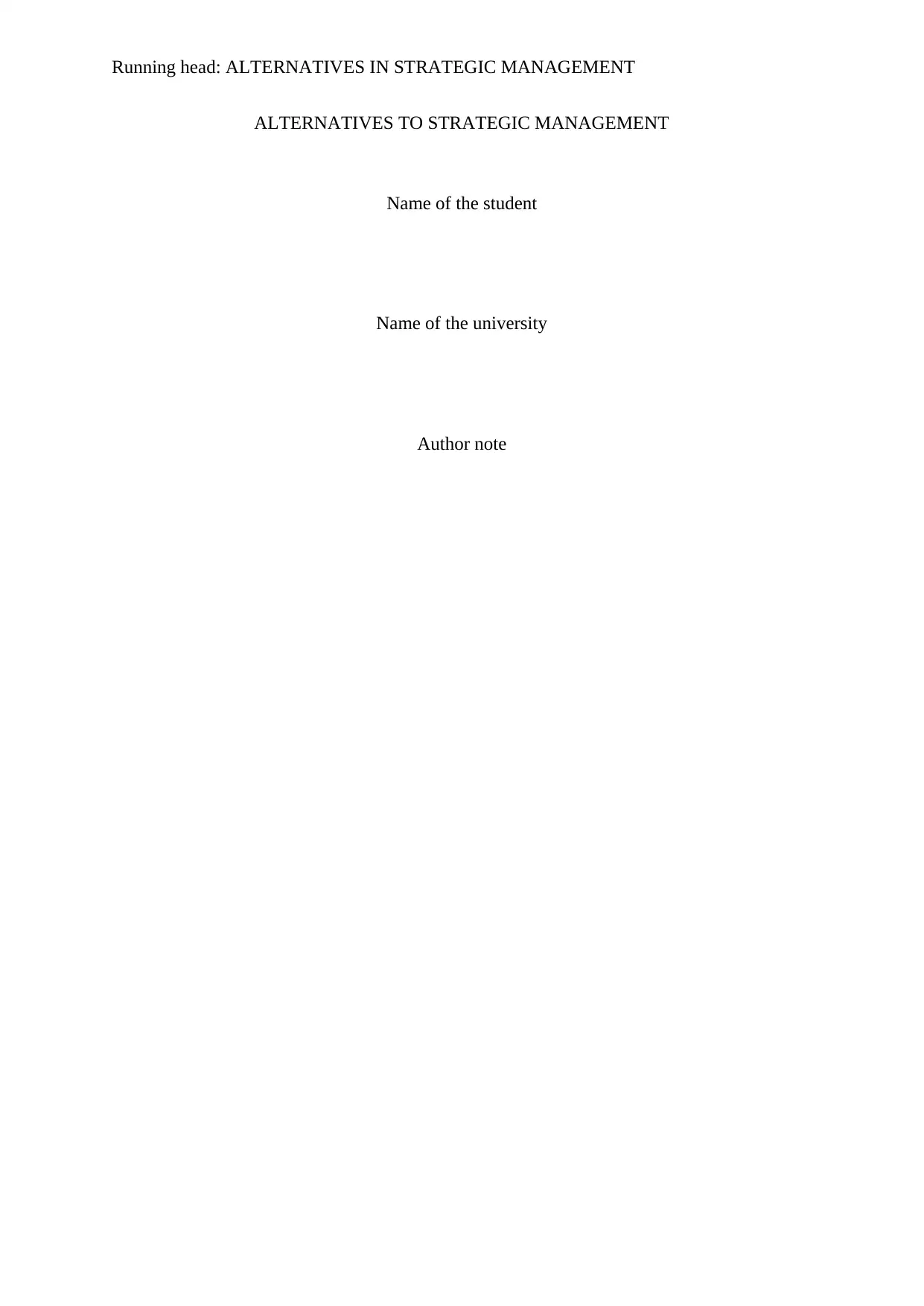
Running head: ALTERNATIVES IN STRATEGIC MANAGEMENT
ALTERNATIVES TO STRATEGIC MANAGEMENT
Name of the student
Name of the university
Author note
ALTERNATIVES TO STRATEGIC MANAGEMENT
Name of the student
Name of the university
Author note
Paraphrase This Document
Need a fresh take? Get an instant paraphrase of this document with our AI Paraphraser
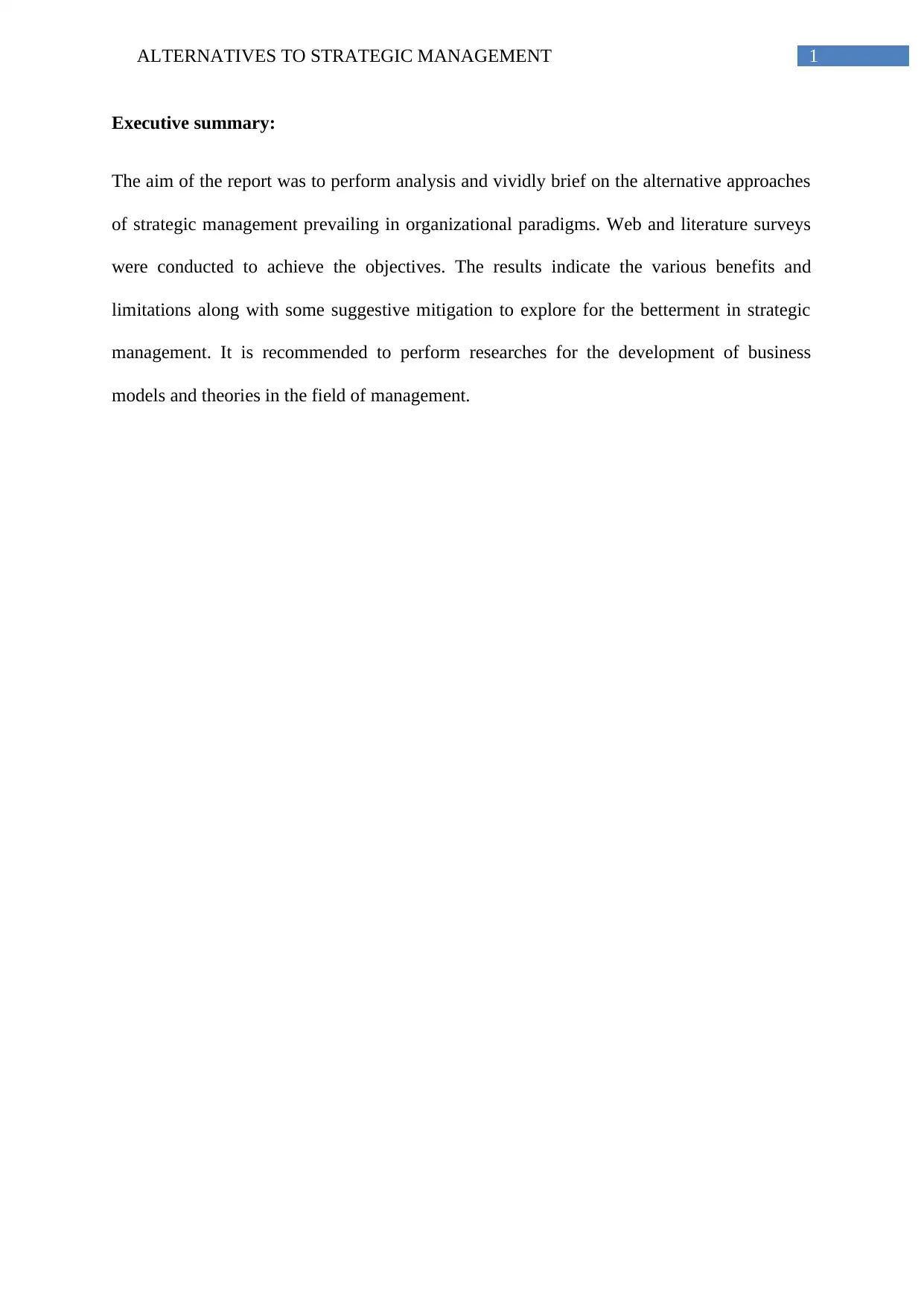
1ALTERNATIVES TO STRATEGIC MANAGEMENT
Executive summary:
The aim of the report was to perform analysis and vividly brief on the alternative approaches
of strategic management prevailing in organizational paradigms. Web and literature surveys
were conducted to achieve the objectives. The results indicate the various benefits and
limitations along with some suggestive mitigation to explore for the betterment in strategic
management. It is recommended to perform researches for the development of business
models and theories in the field of management.
Executive summary:
The aim of the report was to perform analysis and vividly brief on the alternative approaches
of strategic management prevailing in organizational paradigms. Web and literature surveys
were conducted to achieve the objectives. The results indicate the various benefits and
limitations along with some suggestive mitigation to explore for the betterment in strategic
management. It is recommended to perform researches for the development of business
models and theories in the field of management.
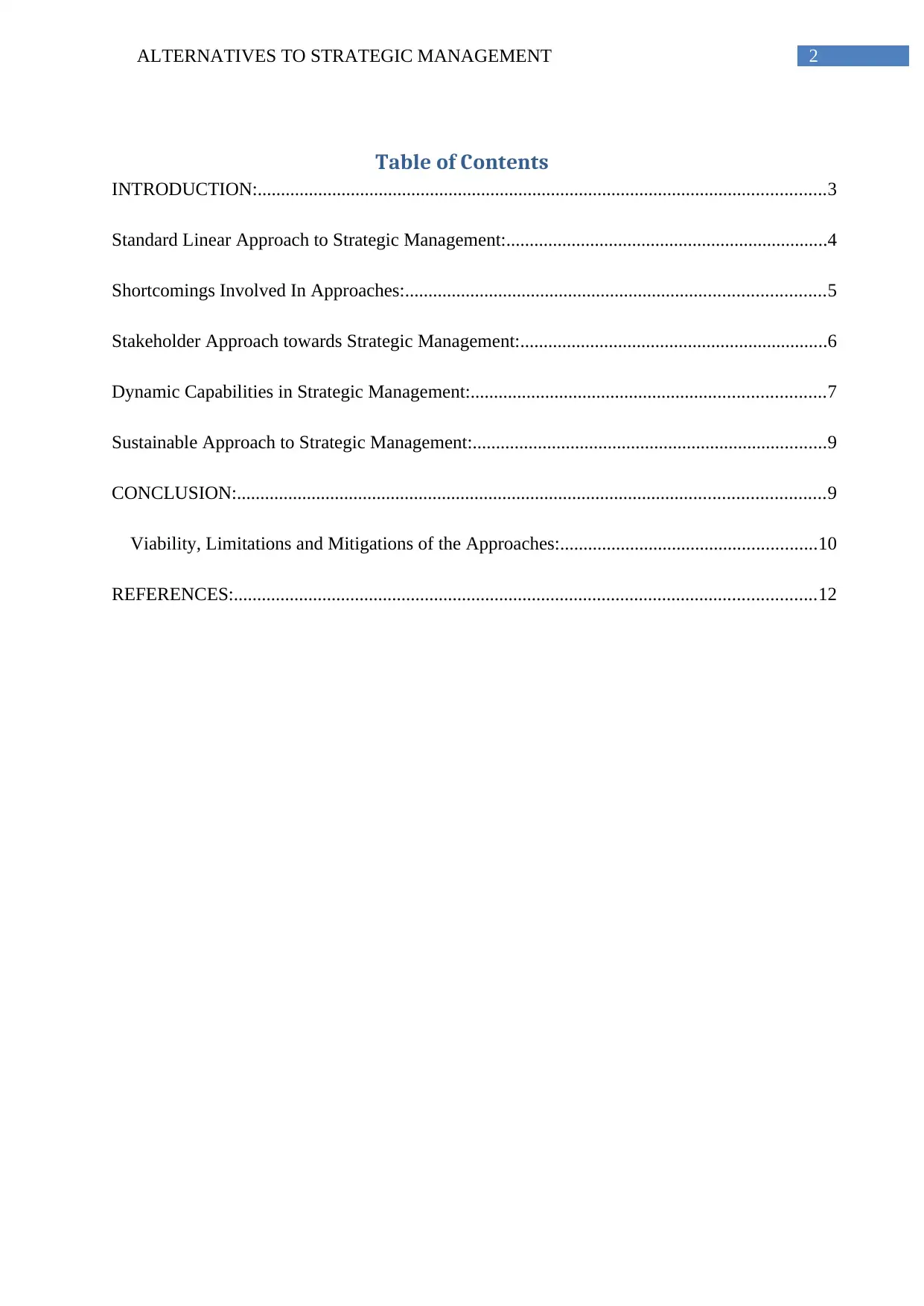
2ALTERNATIVES TO STRATEGIC MANAGEMENT
Table of Contents
INTRODUCTION:..........................................................................................................................3
Standard Linear Approach to Strategic Management:.....................................................................4
Shortcomings Involved In Approaches:..........................................................................................5
Stakeholder Approach towards Strategic Management:..................................................................6
Dynamic Capabilities in Strategic Management:............................................................................7
Sustainable Approach to Strategic Management:............................................................................9
CONCLUSION:..............................................................................................................................9
Viability, Limitations and Mitigations of the Approaches:.......................................................10
REFERENCES:.............................................................................................................................12
Table of Contents
INTRODUCTION:..........................................................................................................................3
Standard Linear Approach to Strategic Management:.....................................................................4
Shortcomings Involved In Approaches:..........................................................................................5
Stakeholder Approach towards Strategic Management:..................................................................6
Dynamic Capabilities in Strategic Management:............................................................................7
Sustainable Approach to Strategic Management:............................................................................9
CONCLUSION:..............................................................................................................................9
Viability, Limitations and Mitigations of the Approaches:.......................................................10
REFERENCES:.............................................................................................................................12
⊘ This is a preview!⊘
Do you want full access?
Subscribe today to unlock all pages.

Trusted by 1+ million students worldwide
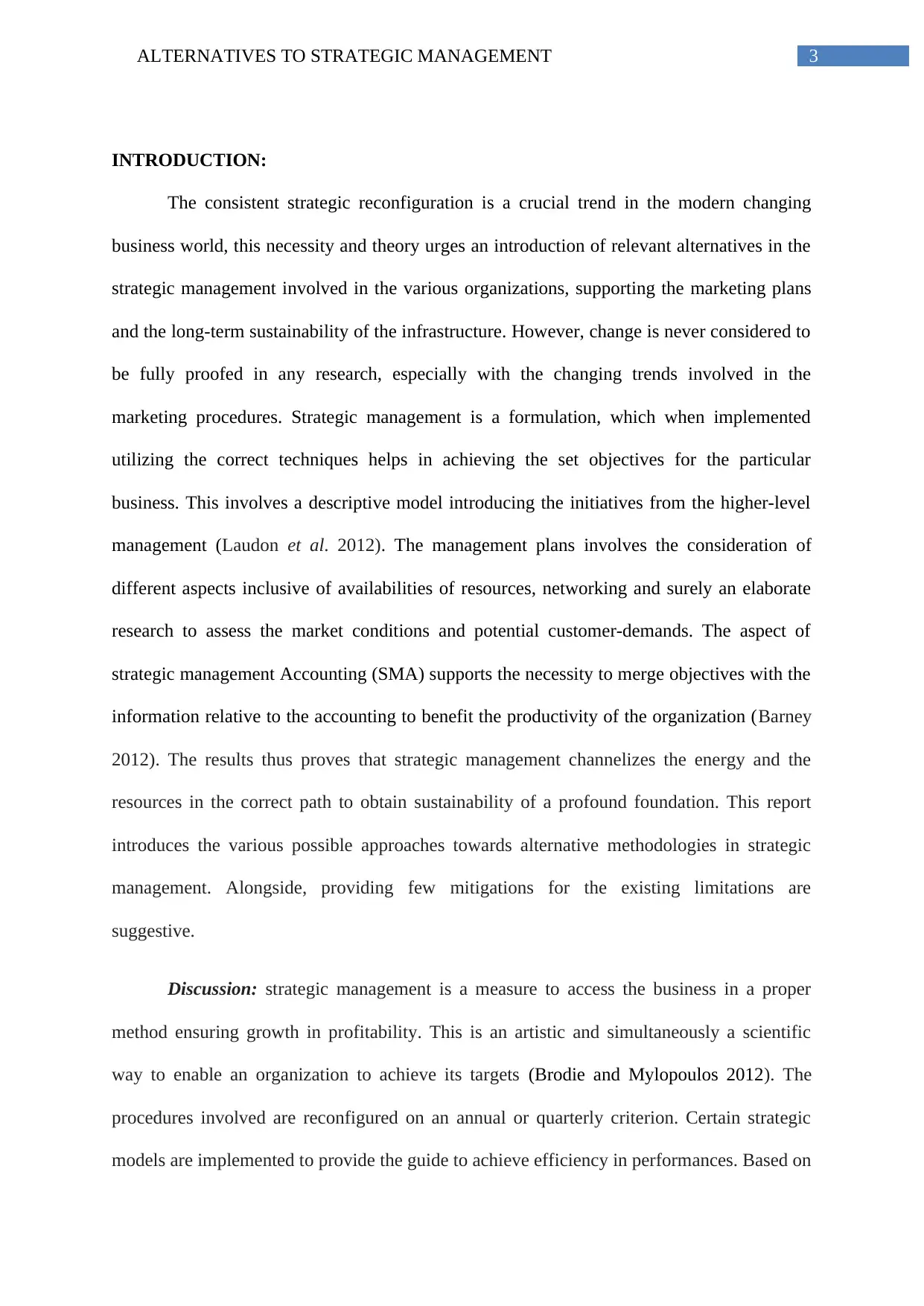
3ALTERNATIVES TO STRATEGIC MANAGEMENT
INTRODUCTION:
The consistent strategic reconfiguration is a crucial trend in the modern changing
business world, this necessity and theory urges an introduction of relevant alternatives in the
strategic management involved in the various organizations, supporting the marketing plans
and the long-term sustainability of the infrastructure. However, change is never considered to
be fully proofed in any research, especially with the changing trends involved in the
marketing procedures. Strategic management is a formulation, which when implemented
utilizing the correct techniques helps in achieving the set objectives for the particular
business. This involves a descriptive model introducing the initiatives from the higher-level
management (Laudon et al. 2012). The management plans involves the consideration of
different aspects inclusive of availabilities of resources, networking and surely an elaborate
research to assess the market conditions and potential customer-demands. The aspect of
strategic management Accounting (SMA) supports the necessity to merge objectives with the
information relative to the accounting to benefit the productivity of the organization (Barney
2012). The results thus proves that strategic management channelizes the energy and the
resources in the correct path to obtain sustainability of a profound foundation. This report
introduces the various possible approaches towards alternative methodologies in strategic
management. Alongside, providing few mitigations for the existing limitations are
suggestive.
Discussion: strategic management is a measure to access the business in a proper
method ensuring growth in profitability. This is an artistic and simultaneously a scientific
way to enable an organization to achieve its targets (Brodie and Mylopoulos 2012). The
procedures involved are reconfigured on an annual or quarterly criterion. Certain strategic
models are implemented to provide the guide to achieve efficiency in performances. Based on
INTRODUCTION:
The consistent strategic reconfiguration is a crucial trend in the modern changing
business world, this necessity and theory urges an introduction of relevant alternatives in the
strategic management involved in the various organizations, supporting the marketing plans
and the long-term sustainability of the infrastructure. However, change is never considered to
be fully proofed in any research, especially with the changing trends involved in the
marketing procedures. Strategic management is a formulation, which when implemented
utilizing the correct techniques helps in achieving the set objectives for the particular
business. This involves a descriptive model introducing the initiatives from the higher-level
management (Laudon et al. 2012). The management plans involves the consideration of
different aspects inclusive of availabilities of resources, networking and surely an elaborate
research to assess the market conditions and potential customer-demands. The aspect of
strategic management Accounting (SMA) supports the necessity to merge objectives with the
information relative to the accounting to benefit the productivity of the organization (Barney
2012). The results thus proves that strategic management channelizes the energy and the
resources in the correct path to obtain sustainability of a profound foundation. This report
introduces the various possible approaches towards alternative methodologies in strategic
management. Alongside, providing few mitigations for the existing limitations are
suggestive.
Discussion: strategic management is a measure to access the business in a proper
method ensuring growth in profitability. This is an artistic and simultaneously a scientific
way to enable an organization to achieve its targets (Brodie and Mylopoulos 2012). The
procedures involved are reconfigured on an annual or quarterly criterion. Certain strategic
models are implemented to provide the guide to achieve efficiency in performances. Based on
Paraphrase This Document
Need a fresh take? Get an instant paraphrase of this document with our AI Paraphraser
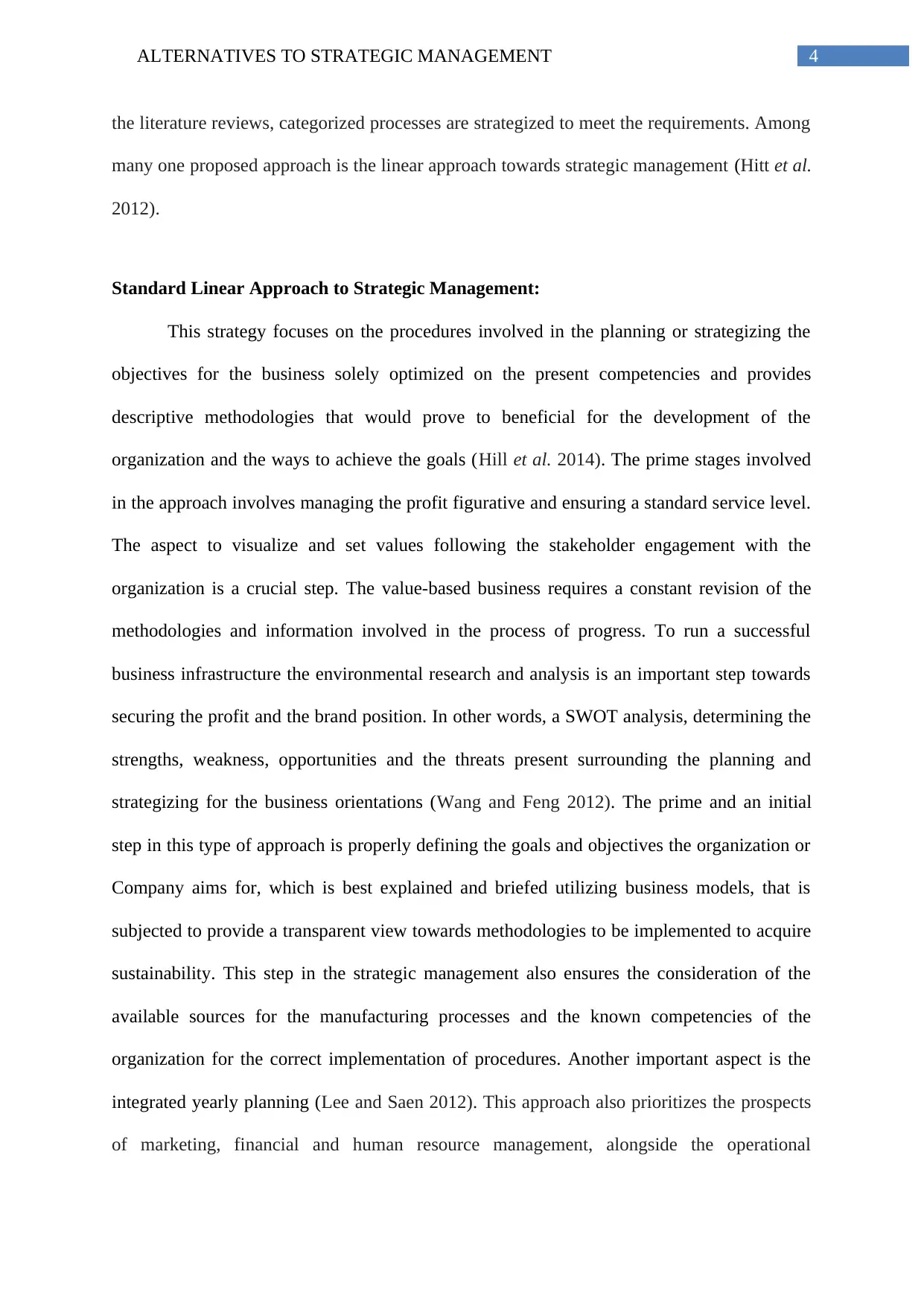
4ALTERNATIVES TO STRATEGIC MANAGEMENT
the literature reviews, categorized processes are strategized to meet the requirements. Among
many one proposed approach is the linear approach towards strategic management (Hitt et al.
2012).
Standard Linear Approach to Strategic Management:
This strategy focuses on the procedures involved in the planning or strategizing the
objectives for the business solely optimized on the present competencies and provides
descriptive methodologies that would prove to beneficial for the development of the
organization and the ways to achieve the goals (Hill et al. 2014). The prime stages involved
in the approach involves managing the profit figurative and ensuring a standard service level.
The aspect to visualize and set values following the stakeholder engagement with the
organization is a crucial step. The value-based business requires a constant revision of the
methodologies and information involved in the process of progress. To run a successful
business infrastructure the environmental research and analysis is an important step towards
securing the profit and the brand position. In other words, a SWOT analysis, determining the
strengths, weakness, opportunities and the threats present surrounding the planning and
strategizing for the business orientations (Wang and Feng 2012). The prime and an initial
step in this type of approach is properly defining the goals and objectives the organization or
Company aims for, which is best explained and briefed utilizing business models, that is
subjected to provide a transparent view towards methodologies to be implemented to acquire
sustainability. This step in the strategic management also ensures the consideration of the
available sources for the manufacturing processes and the known competencies of the
organization for the correct implementation of procedures. Another important aspect is the
integrated yearly planning (Lee and Saen 2012). This approach also prioritizes the prospects
of marketing, financial and human resource management, alongside the operational
the literature reviews, categorized processes are strategized to meet the requirements. Among
many one proposed approach is the linear approach towards strategic management (Hitt et al.
2012).
Standard Linear Approach to Strategic Management:
This strategy focuses on the procedures involved in the planning or strategizing the
objectives for the business solely optimized on the present competencies and provides
descriptive methodologies that would prove to beneficial for the development of the
organization and the ways to achieve the goals (Hill et al. 2014). The prime stages involved
in the approach involves managing the profit figurative and ensuring a standard service level.
The aspect to visualize and set values following the stakeholder engagement with the
organization is a crucial step. The value-based business requires a constant revision of the
methodologies and information involved in the process of progress. To run a successful
business infrastructure the environmental research and analysis is an important step towards
securing the profit and the brand position. In other words, a SWOT analysis, determining the
strengths, weakness, opportunities and the threats present surrounding the planning and
strategizing for the business orientations (Wang and Feng 2012). The prime and an initial
step in this type of approach is properly defining the goals and objectives the organization or
Company aims for, which is best explained and briefed utilizing business models, that is
subjected to provide a transparent view towards methodologies to be implemented to acquire
sustainability. This step in the strategic management also ensures the consideration of the
available sources for the manufacturing processes and the known competencies of the
organization for the correct implementation of procedures. Another important aspect is the
integrated yearly planning (Lee and Saen 2012). This approach also prioritizes the prospects
of marketing, financial and human resource management, alongside the operational
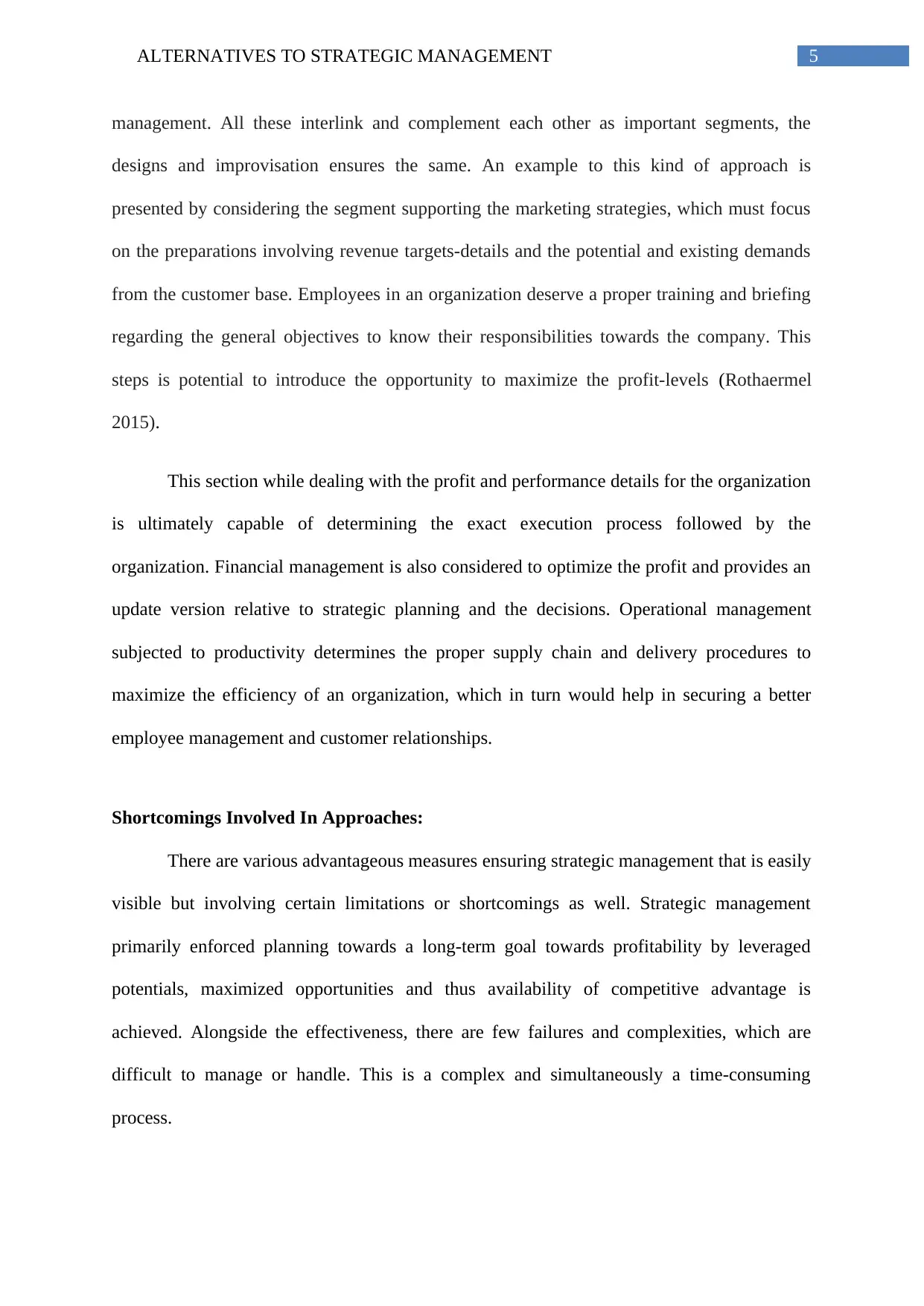
5ALTERNATIVES TO STRATEGIC MANAGEMENT
management. All these interlink and complement each other as important segments, the
designs and improvisation ensures the same. An example to this kind of approach is
presented by considering the segment supporting the marketing strategies, which must focus
on the preparations involving revenue targets-details and the potential and existing demands
from the customer base. Employees in an organization deserve a proper training and briefing
regarding the general objectives to know their responsibilities towards the company. This
steps is potential to introduce the opportunity to maximize the profit-levels (Rothaermel
2015).
This section while dealing with the profit and performance details for the organization
is ultimately capable of determining the exact execution process followed by the
organization. Financial management is also considered to optimize the profit and provides an
update version relative to strategic planning and the decisions. Operational management
subjected to productivity determines the proper supply chain and delivery procedures to
maximize the efficiency of an organization, which in turn would help in securing a better
employee management and customer relationships.
Shortcomings Involved In Approaches:
There are various advantageous measures ensuring strategic management that is easily
visible but involving certain limitations or shortcomings as well. Strategic management
primarily enforced planning towards a long-term goal towards profitability by leveraged
potentials, maximized opportunities and thus availability of competitive advantage is
achieved. Alongside the effectiveness, there are few failures and complexities, which are
difficult to manage or handle. This is a complex and simultaneously a time-consuming
process.
management. All these interlink and complement each other as important segments, the
designs and improvisation ensures the same. An example to this kind of approach is
presented by considering the segment supporting the marketing strategies, which must focus
on the preparations involving revenue targets-details and the potential and existing demands
from the customer base. Employees in an organization deserve a proper training and briefing
regarding the general objectives to know their responsibilities towards the company. This
steps is potential to introduce the opportunity to maximize the profit-levels (Rothaermel
2015).
This section while dealing with the profit and performance details for the organization
is ultimately capable of determining the exact execution process followed by the
organization. Financial management is also considered to optimize the profit and provides an
update version relative to strategic planning and the decisions. Operational management
subjected to productivity determines the proper supply chain and delivery procedures to
maximize the efficiency of an organization, which in turn would help in securing a better
employee management and customer relationships.
Shortcomings Involved In Approaches:
There are various advantageous measures ensuring strategic management that is easily
visible but involving certain limitations or shortcomings as well. Strategic management
primarily enforced planning towards a long-term goal towards profitability by leveraged
potentials, maximized opportunities and thus availability of competitive advantage is
achieved. Alongside the effectiveness, there are few failures and complexities, which are
difficult to manage or handle. This is a complex and simultaneously a time-consuming
process.
⊘ This is a preview!⊘
Do you want full access?
Subscribe today to unlock all pages.

Trusted by 1+ million students worldwide
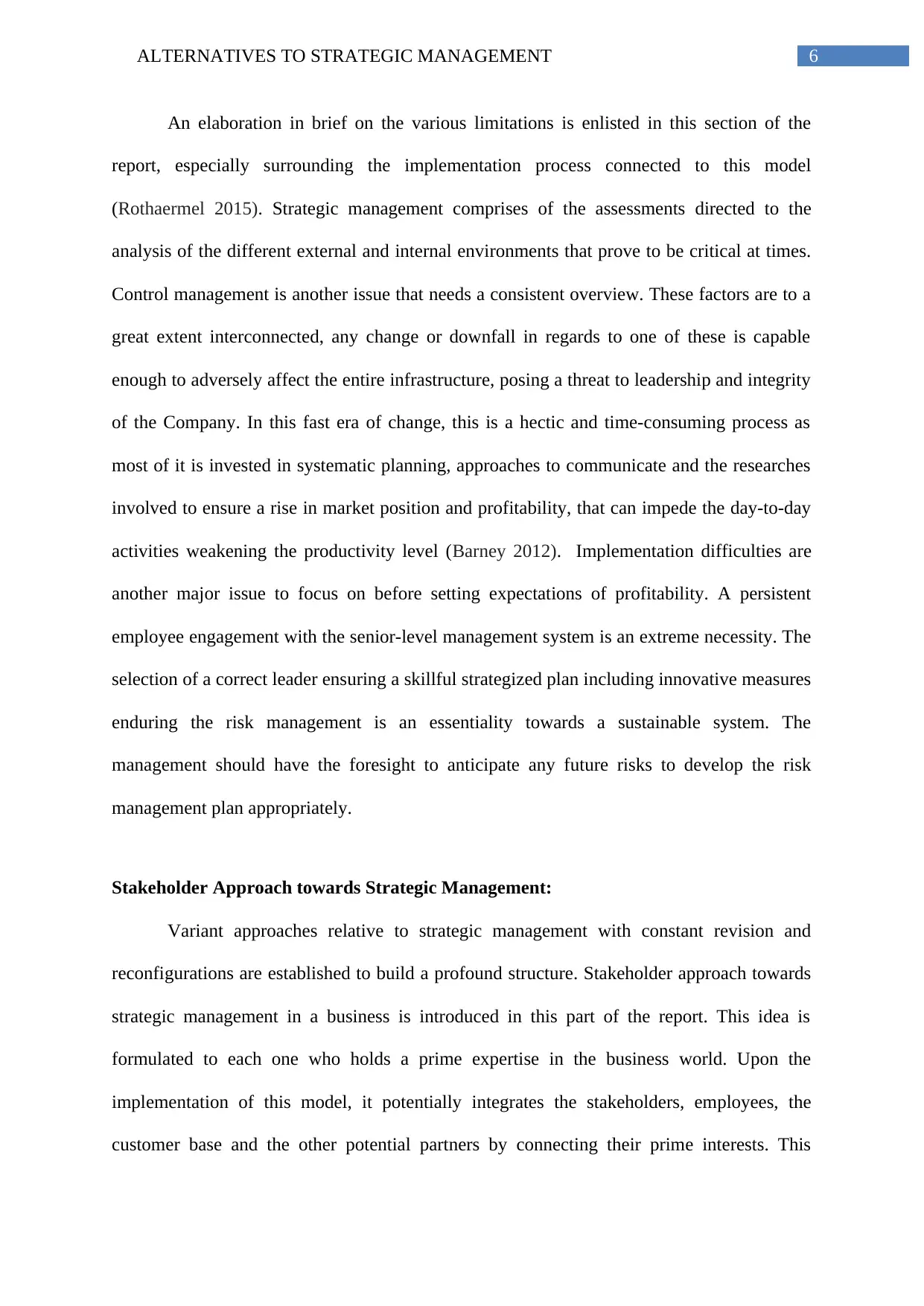
6ALTERNATIVES TO STRATEGIC MANAGEMENT
An elaboration in brief on the various limitations is enlisted in this section of the
report, especially surrounding the implementation process connected to this model
(Rothaermel 2015). Strategic management comprises of the assessments directed to the
analysis of the different external and internal environments that prove to be critical at times.
Control management is another issue that needs a consistent overview. These factors are to a
great extent interconnected, any change or downfall in regards to one of these is capable
enough to adversely affect the entire infrastructure, posing a threat to leadership and integrity
of the Company. In this fast era of change, this is a hectic and time-consuming process as
most of it is invested in systematic planning, approaches to communicate and the researches
involved to ensure a rise in market position and profitability, that can impede the day-to-day
activities weakening the productivity level (Barney 2012). Implementation difficulties are
another major issue to focus on before setting expectations of profitability. A persistent
employee engagement with the senior-level management system is an extreme necessity. The
selection of a correct leader ensuring a skillful strategized plan including innovative measures
enduring the risk management is an essentiality towards a sustainable system. The
management should have the foresight to anticipate any future risks to develop the risk
management plan appropriately.
Stakeholder Approach towards Strategic Management:
Variant approaches relative to strategic management with constant revision and
reconfigurations are established to build a profound structure. Stakeholder approach towards
strategic management in a business is introduced in this part of the report. This idea is
formulated to each one who holds a prime expertise in the business world. Upon the
implementation of this model, it potentially integrates the stakeholders, employees, the
customer base and the other potential partners by connecting their prime interests. This
An elaboration in brief on the various limitations is enlisted in this section of the
report, especially surrounding the implementation process connected to this model
(Rothaermel 2015). Strategic management comprises of the assessments directed to the
analysis of the different external and internal environments that prove to be critical at times.
Control management is another issue that needs a consistent overview. These factors are to a
great extent interconnected, any change or downfall in regards to one of these is capable
enough to adversely affect the entire infrastructure, posing a threat to leadership and integrity
of the Company. In this fast era of change, this is a hectic and time-consuming process as
most of it is invested in systematic planning, approaches to communicate and the researches
involved to ensure a rise in market position and profitability, that can impede the day-to-day
activities weakening the productivity level (Barney 2012). Implementation difficulties are
another major issue to focus on before setting expectations of profitability. A persistent
employee engagement with the senior-level management system is an extreme necessity. The
selection of a correct leader ensuring a skillful strategized plan including innovative measures
enduring the risk management is an essentiality towards a sustainable system. The
management should have the foresight to anticipate any future risks to develop the risk
management plan appropriately.
Stakeholder Approach towards Strategic Management:
Variant approaches relative to strategic management with constant revision and
reconfigurations are established to build a profound structure. Stakeholder approach towards
strategic management in a business is introduced in this part of the report. This idea is
formulated to each one who holds a prime expertise in the business world. Upon the
implementation of this model, it potentially integrates the stakeholders, employees, the
customer base and the other potential partners by connecting their prime interests. This
Paraphrase This Document
Need a fresh take? Get an instant paraphrase of this document with our AI Paraphraser
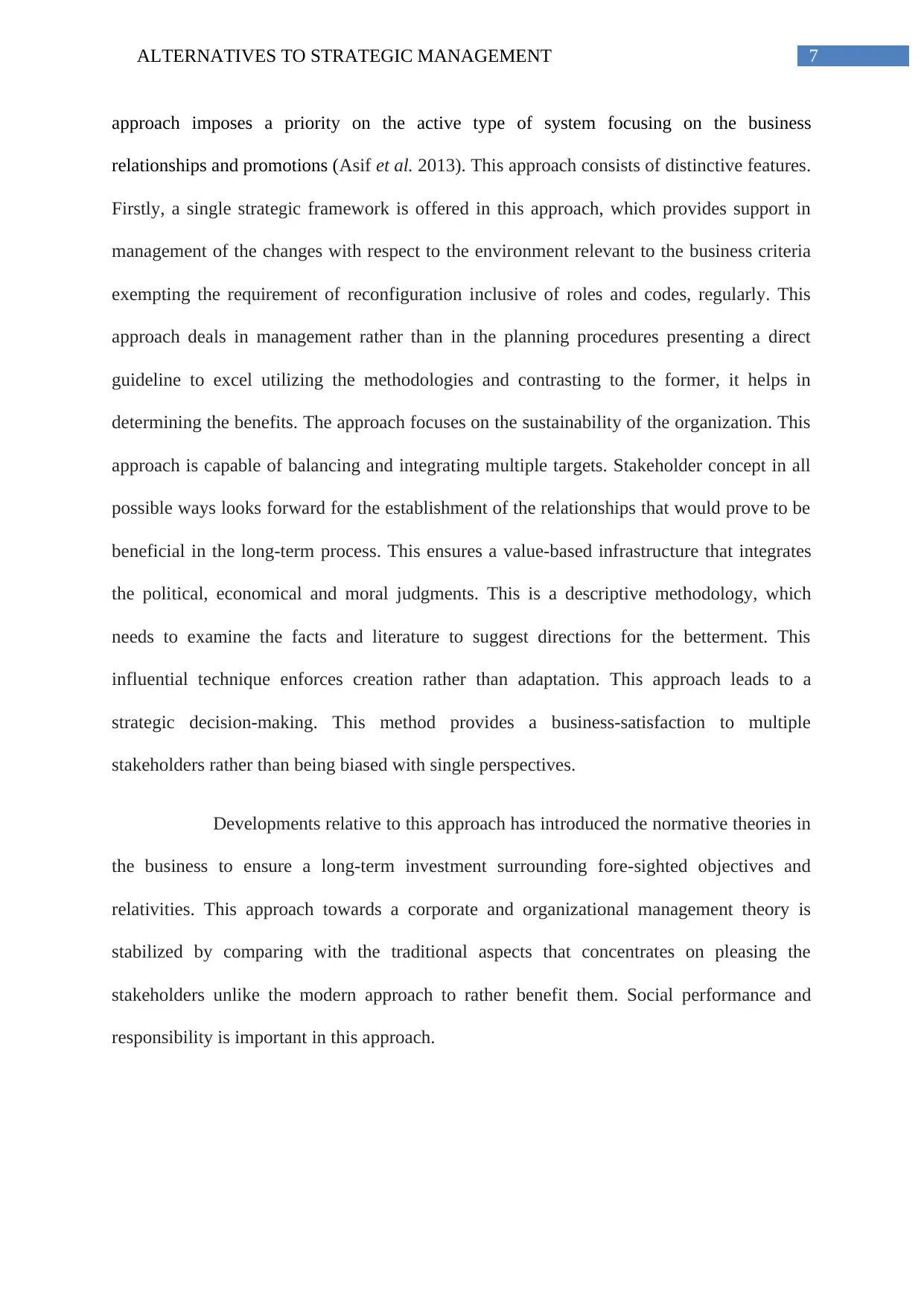
7ALTERNATIVES TO STRATEGIC MANAGEMENT
approach imposes a priority on the active type of system focusing on the business
relationships and promotions (Asif et al. 2013). This approach consists of distinctive features.
Firstly, a single strategic framework is offered in this approach, which provides support in
management of the changes with respect to the environment relevant to the business criteria
exempting the requirement of reconfiguration inclusive of roles and codes, regularly. This
approach deals in management rather than in the planning procedures presenting a direct
guideline to excel utilizing the methodologies and contrasting to the former, it helps in
determining the benefits. The approach focuses on the sustainability of the organization. This
approach is capable of balancing and integrating multiple targets. Stakeholder concept in all
possible ways looks forward for the establishment of the relationships that would prove to be
beneficial in the long-term process. This ensures a value-based infrastructure that integrates
the political, economical and moral judgments. This is a descriptive methodology, which
needs to examine the facts and literature to suggest directions for the betterment. This
influential technique enforces creation rather than adaptation. This approach leads to a
strategic decision-making. This method provides a business-satisfaction to multiple
stakeholders rather than being biased with single perspectives.
Developments relative to this approach has introduced the normative theories in
the business to ensure a long-term investment surrounding fore-sighted objectives and
relativities. This approach towards a corporate and organizational management theory is
stabilized by comparing with the traditional aspects that concentrates on pleasing the
stakeholders unlike the modern approach to rather benefit them. Social performance and
responsibility is important in this approach.
approach imposes a priority on the active type of system focusing on the business
relationships and promotions (Asif et al. 2013). This approach consists of distinctive features.
Firstly, a single strategic framework is offered in this approach, which provides support in
management of the changes with respect to the environment relevant to the business criteria
exempting the requirement of reconfiguration inclusive of roles and codes, regularly. This
approach deals in management rather than in the planning procedures presenting a direct
guideline to excel utilizing the methodologies and contrasting to the former, it helps in
determining the benefits. The approach focuses on the sustainability of the organization. This
approach is capable of balancing and integrating multiple targets. Stakeholder concept in all
possible ways looks forward for the establishment of the relationships that would prove to be
beneficial in the long-term process. This ensures a value-based infrastructure that integrates
the political, economical and moral judgments. This is a descriptive methodology, which
needs to examine the facts and literature to suggest directions for the betterment. This
influential technique enforces creation rather than adaptation. This approach leads to a
strategic decision-making. This method provides a business-satisfaction to multiple
stakeholders rather than being biased with single perspectives.
Developments relative to this approach has introduced the normative theories in
the business to ensure a long-term investment surrounding fore-sighted objectives and
relativities. This approach towards a corporate and organizational management theory is
stabilized by comparing with the traditional aspects that concentrates on pleasing the
stakeholders unlike the modern approach to rather benefit them. Social performance and
responsibility is important in this approach.
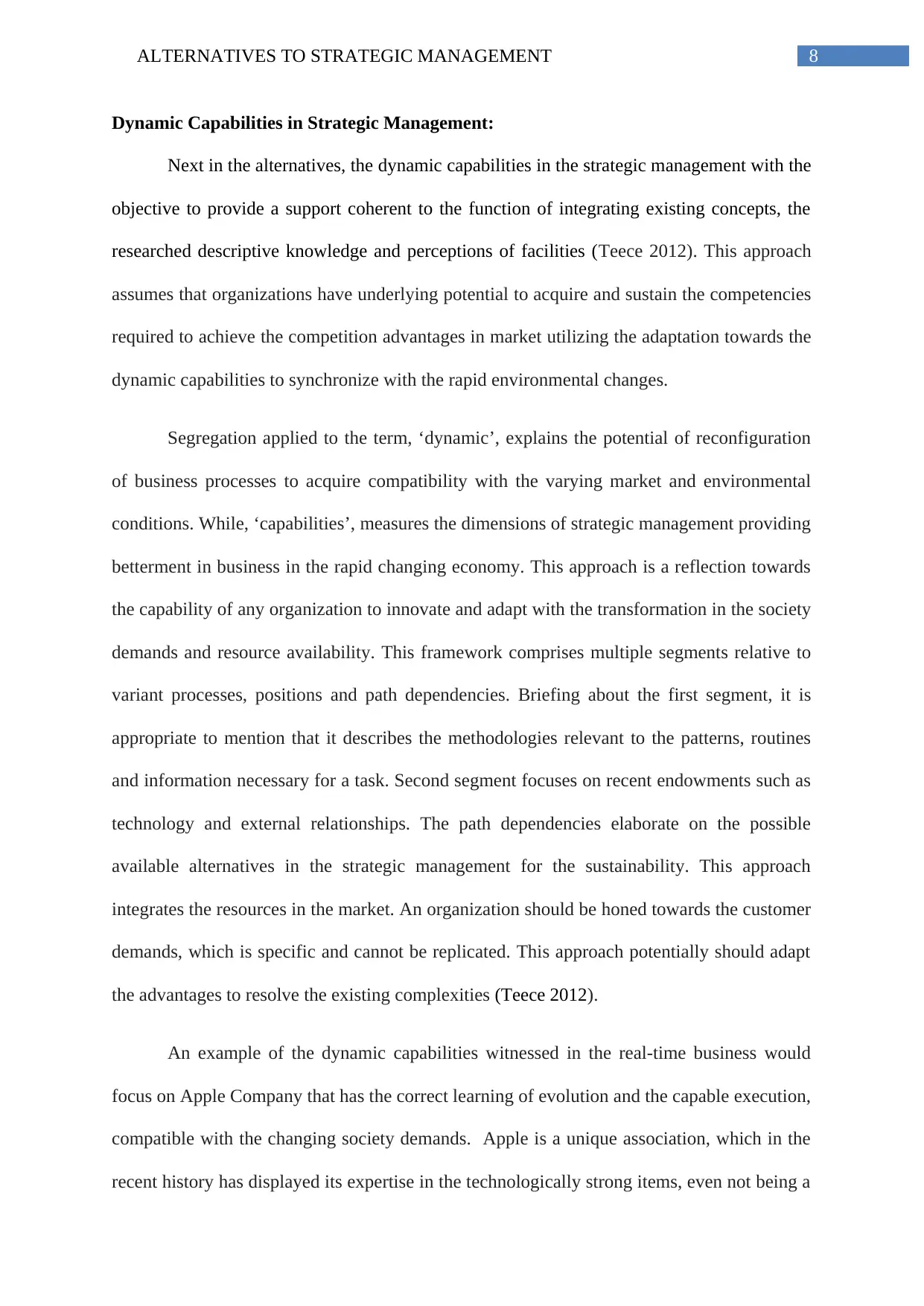
8ALTERNATIVES TO STRATEGIC MANAGEMENT
Dynamic Capabilities in Strategic Management:
Next in the alternatives, the dynamic capabilities in the strategic management with the
objective to provide a support coherent to the function of integrating existing concepts, the
researched descriptive knowledge and perceptions of facilities (Teece 2012). This approach
assumes that organizations have underlying potential to acquire and sustain the competencies
required to achieve the competition advantages in market utilizing the adaptation towards the
dynamic capabilities to synchronize with the rapid environmental changes.
Segregation applied to the term, ‘dynamic’, explains the potential of reconfiguration
of business processes to acquire compatibility with the varying market and environmental
conditions. While, ‘capabilities’, measures the dimensions of strategic management providing
betterment in business in the rapid changing economy. This approach is a reflection towards
the capability of any organization to innovate and adapt with the transformation in the society
demands and resource availability. This framework comprises multiple segments relative to
variant processes, positions and path dependencies. Briefing about the first segment, it is
appropriate to mention that it describes the methodologies relevant to the patterns, routines
and information necessary for a task. Second segment focuses on recent endowments such as
technology and external relationships. The path dependencies elaborate on the possible
available alternatives in the strategic management for the sustainability. This approach
integrates the resources in the market. An organization should be honed towards the customer
demands, which is specific and cannot be replicated. This approach potentially should adapt
the advantages to resolve the existing complexities (Teece 2012).
An example of the dynamic capabilities witnessed in the real-time business would
focus on Apple Company that has the correct learning of evolution and the capable execution,
compatible with the changing society demands. Apple is a unique association, which in the
recent history has displayed its expertise in the technologically strong items, even not being a
Dynamic Capabilities in Strategic Management:
Next in the alternatives, the dynamic capabilities in the strategic management with the
objective to provide a support coherent to the function of integrating existing concepts, the
researched descriptive knowledge and perceptions of facilities (Teece 2012). This approach
assumes that organizations have underlying potential to acquire and sustain the competencies
required to achieve the competition advantages in market utilizing the adaptation towards the
dynamic capabilities to synchronize with the rapid environmental changes.
Segregation applied to the term, ‘dynamic’, explains the potential of reconfiguration
of business processes to acquire compatibility with the varying market and environmental
conditions. While, ‘capabilities’, measures the dimensions of strategic management providing
betterment in business in the rapid changing economy. This approach is a reflection towards
the capability of any organization to innovate and adapt with the transformation in the society
demands and resource availability. This framework comprises multiple segments relative to
variant processes, positions and path dependencies. Briefing about the first segment, it is
appropriate to mention that it describes the methodologies relevant to the patterns, routines
and information necessary for a task. Second segment focuses on recent endowments such as
technology and external relationships. The path dependencies elaborate on the possible
available alternatives in the strategic management for the sustainability. This approach
integrates the resources in the market. An organization should be honed towards the customer
demands, which is specific and cannot be replicated. This approach potentially should adapt
the advantages to resolve the existing complexities (Teece 2012).
An example of the dynamic capabilities witnessed in the real-time business would
focus on Apple Company that has the correct learning of evolution and the capable execution,
compatible with the changing society demands. Apple is a unique association, which in the
recent history has displayed its expertise in the technologically strong items, even not being a
⊘ This is a preview!⊘
Do you want full access?
Subscribe today to unlock all pages.

Trusted by 1+ million students worldwide
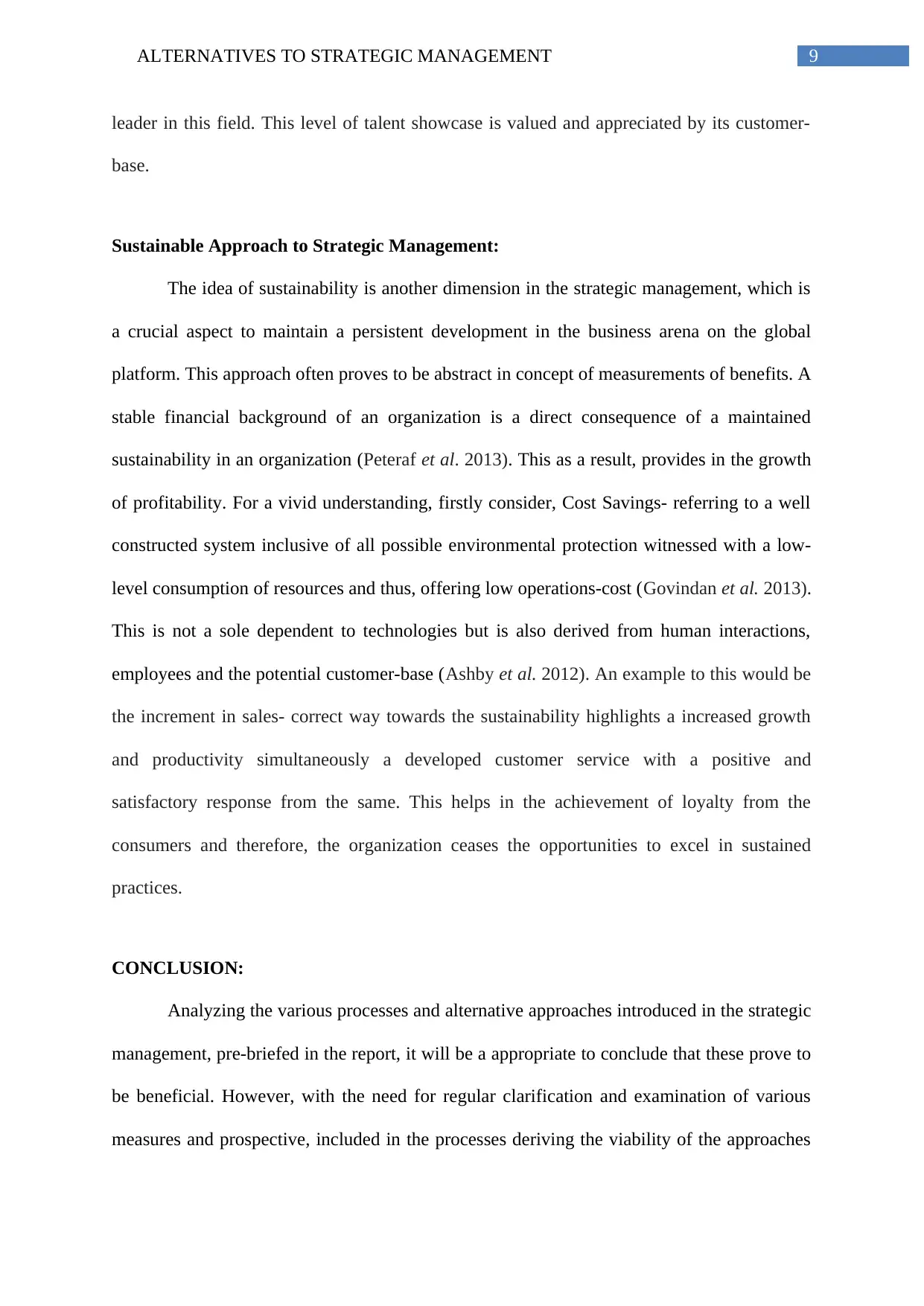
9ALTERNATIVES TO STRATEGIC MANAGEMENT
leader in this field. This level of talent showcase is valued and appreciated by its customer-
base.
Sustainable Approach to Strategic Management:
The idea of sustainability is another dimension in the strategic management, which is
a crucial aspect to maintain a persistent development in the business arena on the global
platform. This approach often proves to be abstract in concept of measurements of benefits. A
stable financial background of an organization is a direct consequence of a maintained
sustainability in an organization (Peteraf et al. 2013). This as a result, provides in the growth
of profitability. For a vivid understanding, firstly consider, Cost Savings- referring to a well
constructed system inclusive of all possible environmental protection witnessed with a low-
level consumption of resources and thus, offering low operations-cost (Govindan et al. 2013).
This is not a sole dependent to technologies but is also derived from human interactions,
employees and the potential customer-base (Ashby et al. 2012). An example to this would be
the increment in sales- correct way towards the sustainability highlights a increased growth
and productivity simultaneously a developed customer service with a positive and
satisfactory response from the same. This helps in the achievement of loyalty from the
consumers and therefore, the organization ceases the opportunities to excel in sustained
practices.
CONCLUSION:
Analyzing the various processes and alternative approaches introduced in the strategic
management, pre-briefed in the report, it will be a appropriate to conclude that these prove to
be beneficial. However, with the need for regular clarification and examination of various
measures and prospective, included in the processes deriving the viability of the approaches
leader in this field. This level of talent showcase is valued and appreciated by its customer-
base.
Sustainable Approach to Strategic Management:
The idea of sustainability is another dimension in the strategic management, which is
a crucial aspect to maintain a persistent development in the business arena on the global
platform. This approach often proves to be abstract in concept of measurements of benefits. A
stable financial background of an organization is a direct consequence of a maintained
sustainability in an organization (Peteraf et al. 2013). This as a result, provides in the growth
of profitability. For a vivid understanding, firstly consider, Cost Savings- referring to a well
constructed system inclusive of all possible environmental protection witnessed with a low-
level consumption of resources and thus, offering low operations-cost (Govindan et al. 2013).
This is not a sole dependent to technologies but is also derived from human interactions,
employees and the potential customer-base (Ashby et al. 2012). An example to this would be
the increment in sales- correct way towards the sustainability highlights a increased growth
and productivity simultaneously a developed customer service with a positive and
satisfactory response from the same. This helps in the achievement of loyalty from the
consumers and therefore, the organization ceases the opportunities to excel in sustained
practices.
CONCLUSION:
Analyzing the various processes and alternative approaches introduced in the strategic
management, pre-briefed in the report, it will be a appropriate to conclude that these prove to
be beneficial. However, with the need for regular clarification and examination of various
measures and prospective, included in the processes deriving the viability of the approaches
Paraphrase This Document
Need a fresh take? Get an instant paraphrase of this document with our AI Paraphraser
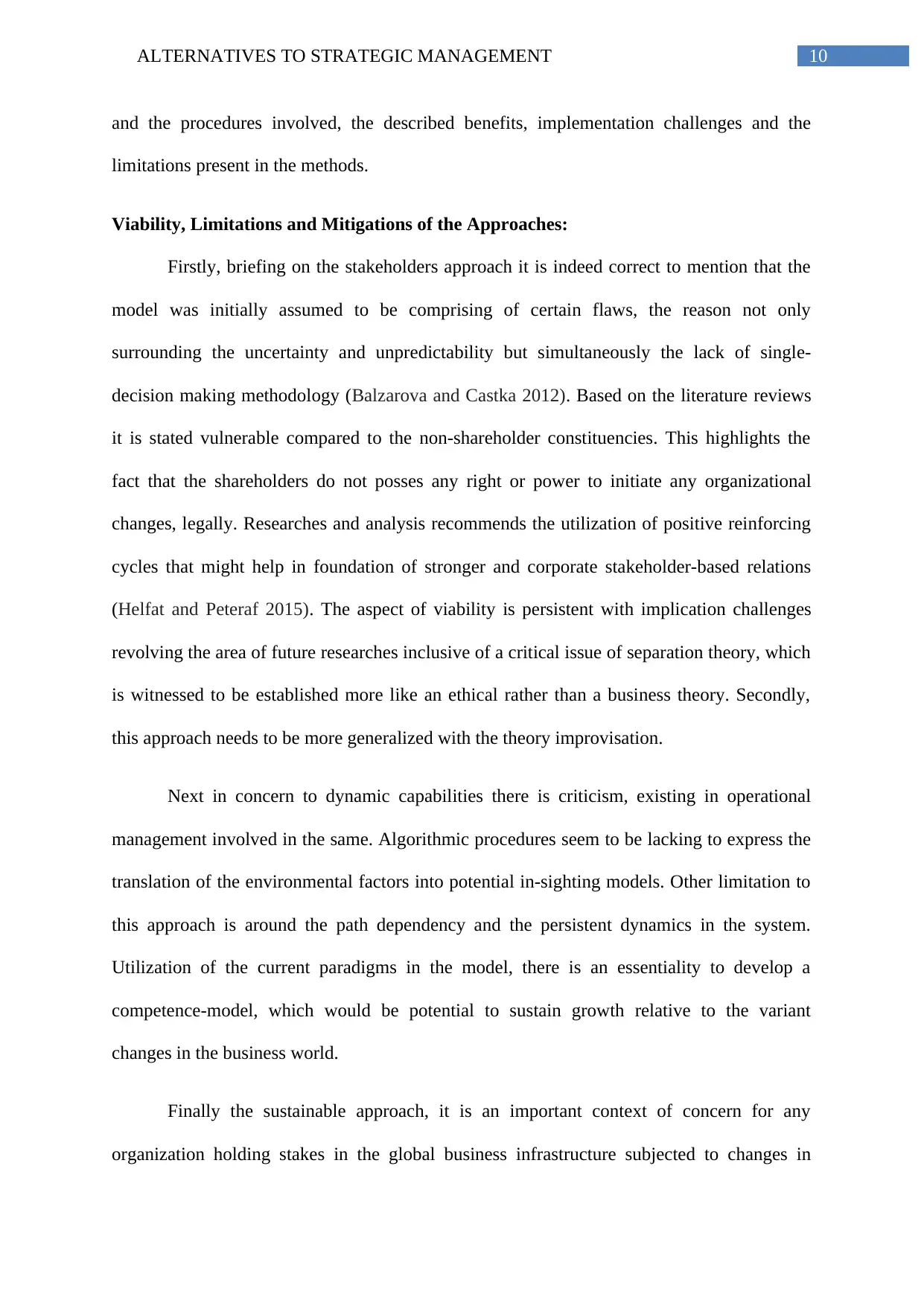
10ALTERNATIVES TO STRATEGIC MANAGEMENT
and the procedures involved, the described benefits, implementation challenges and the
limitations present in the methods.
Viability, Limitations and Mitigations of the Approaches:
Firstly, briefing on the stakeholders approach it is indeed correct to mention that the
model was initially assumed to be comprising of certain flaws, the reason not only
surrounding the uncertainty and unpredictability but simultaneously the lack of single-
decision making methodology (Balzarova and Castka 2012). Based on the literature reviews
it is stated vulnerable compared to the non-shareholder constituencies. This highlights the
fact that the shareholders do not posses any right or power to initiate any organizational
changes, legally. Researches and analysis recommends the utilization of positive reinforcing
cycles that might help in foundation of stronger and corporate stakeholder-based relations
(Helfat and Peteraf 2015). The aspect of viability is persistent with implication challenges
revolving the area of future researches inclusive of a critical issue of separation theory, which
is witnessed to be established more like an ethical rather than a business theory. Secondly,
this approach needs to be more generalized with the theory improvisation.
Next in concern to dynamic capabilities there is criticism, existing in operational
management involved in the same. Algorithmic procedures seem to be lacking to express the
translation of the environmental factors into potential in-sighting models. Other limitation to
this approach is around the path dependency and the persistent dynamics in the system.
Utilization of the current paradigms in the model, there is an essentiality to develop a
competence-model, which would be potential to sustain growth relative to the variant
changes in the business world.
Finally the sustainable approach, it is an important context of concern for any
organization holding stakes in the global business infrastructure subjected to changes in
and the procedures involved, the described benefits, implementation challenges and the
limitations present in the methods.
Viability, Limitations and Mitigations of the Approaches:
Firstly, briefing on the stakeholders approach it is indeed correct to mention that the
model was initially assumed to be comprising of certain flaws, the reason not only
surrounding the uncertainty and unpredictability but simultaneously the lack of single-
decision making methodology (Balzarova and Castka 2012). Based on the literature reviews
it is stated vulnerable compared to the non-shareholder constituencies. This highlights the
fact that the shareholders do not posses any right or power to initiate any organizational
changes, legally. Researches and analysis recommends the utilization of positive reinforcing
cycles that might help in foundation of stronger and corporate stakeholder-based relations
(Helfat and Peteraf 2015). The aspect of viability is persistent with implication challenges
revolving the area of future researches inclusive of a critical issue of separation theory, which
is witnessed to be established more like an ethical rather than a business theory. Secondly,
this approach needs to be more generalized with the theory improvisation.
Next in concern to dynamic capabilities there is criticism, existing in operational
management involved in the same. Algorithmic procedures seem to be lacking to express the
translation of the environmental factors into potential in-sighting models. Other limitation to
this approach is around the path dependency and the persistent dynamics in the system.
Utilization of the current paradigms in the model, there is an essentiality to develop a
competence-model, which would be potential to sustain growth relative to the variant
changes in the business world.
Finally the sustainable approach, it is an important context of concern for any
organization holding stakes in the global business infrastructure subjected to changes in
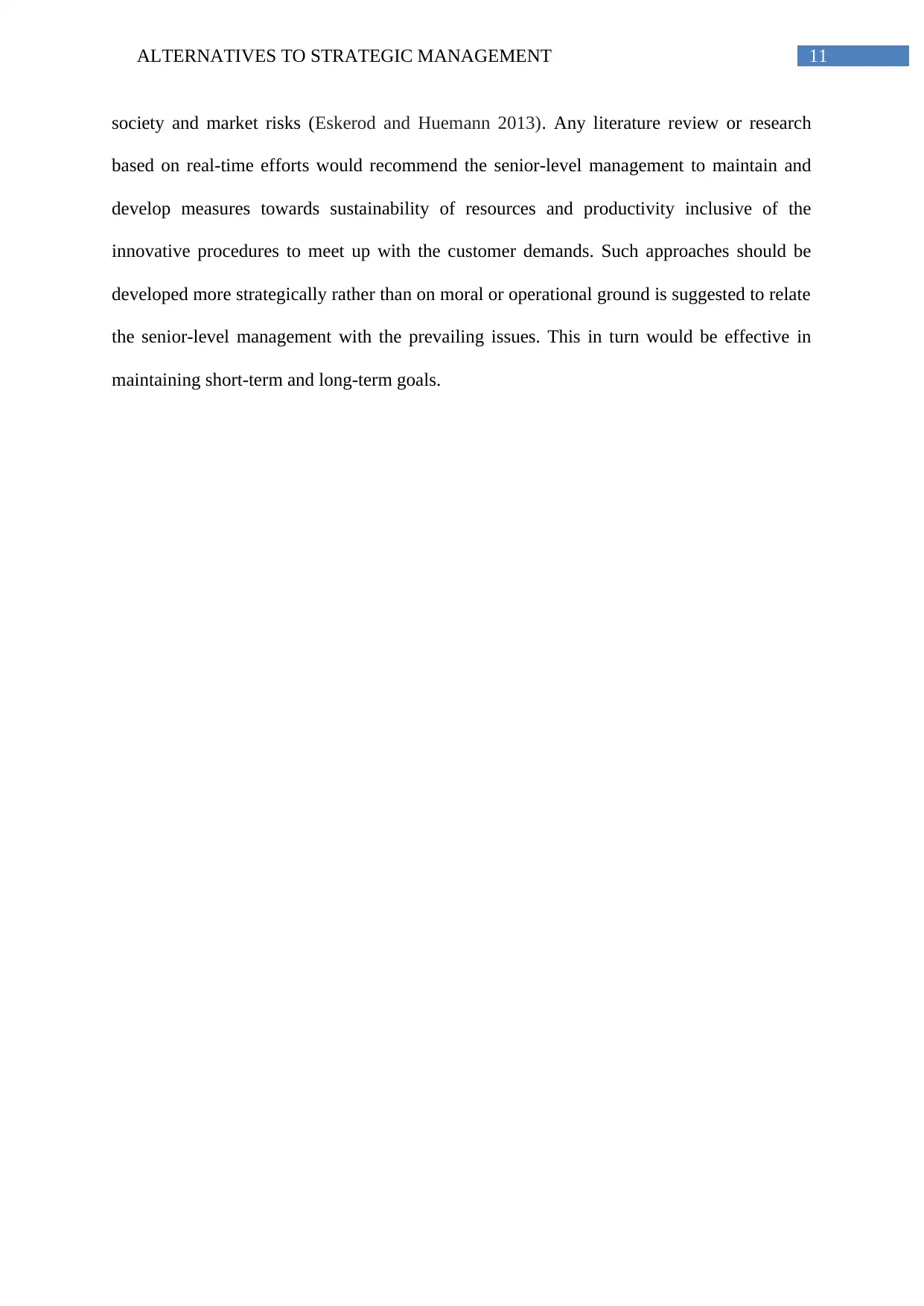
11ALTERNATIVES TO STRATEGIC MANAGEMENT
society and market risks (Eskerod and Huemann 2013). Any literature review or research
based on real-time efforts would recommend the senior-level management to maintain and
develop measures towards sustainability of resources and productivity inclusive of the
innovative procedures to meet up with the customer demands. Such approaches should be
developed more strategically rather than on moral or operational ground is suggested to relate
the senior-level management with the prevailing issues. This in turn would be effective in
maintaining short-term and long-term goals.
society and market risks (Eskerod and Huemann 2013). Any literature review or research
based on real-time efforts would recommend the senior-level management to maintain and
develop measures towards sustainability of resources and productivity inclusive of the
innovative procedures to meet up with the customer demands. Such approaches should be
developed more strategically rather than on moral or operational ground is suggested to relate
the senior-level management with the prevailing issues. This in turn would be effective in
maintaining short-term and long-term goals.
⊘ This is a preview!⊘
Do you want full access?
Subscribe today to unlock all pages.

Trusted by 1+ million students worldwide
1 out of 15
Related Documents
Your All-in-One AI-Powered Toolkit for Academic Success.
+13062052269
info@desklib.com
Available 24*7 on WhatsApp / Email
![[object Object]](/_next/static/media/star-bottom.7253800d.svg)
Unlock your academic potential
Copyright © 2020–2025 A2Z Services. All Rights Reserved. Developed and managed by ZUCOL.





